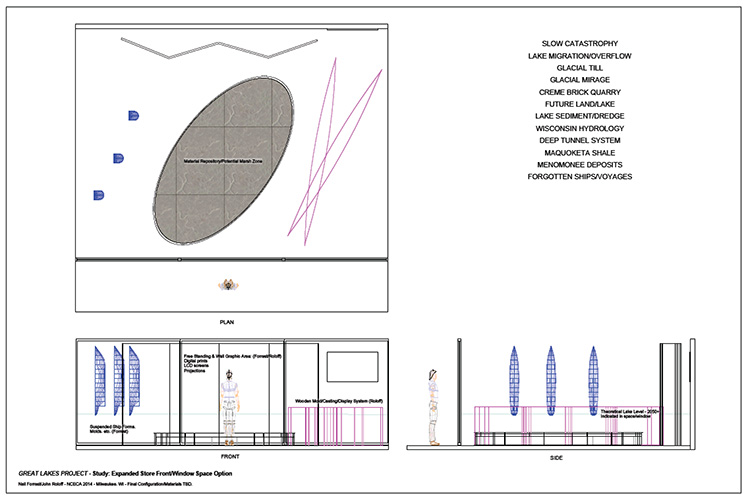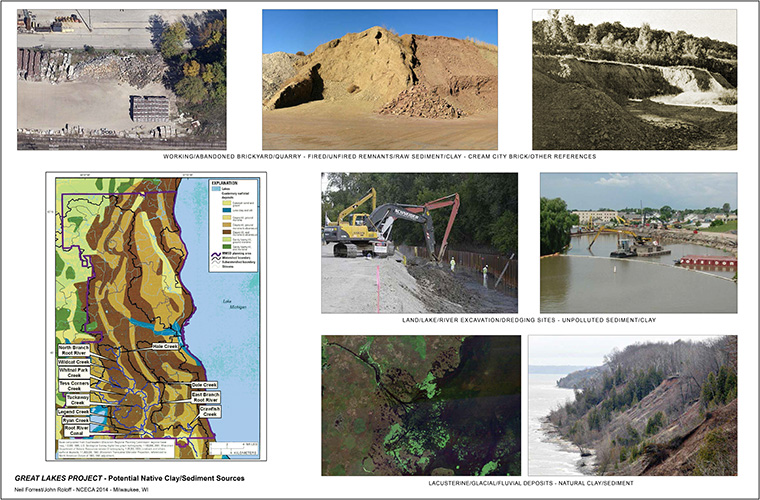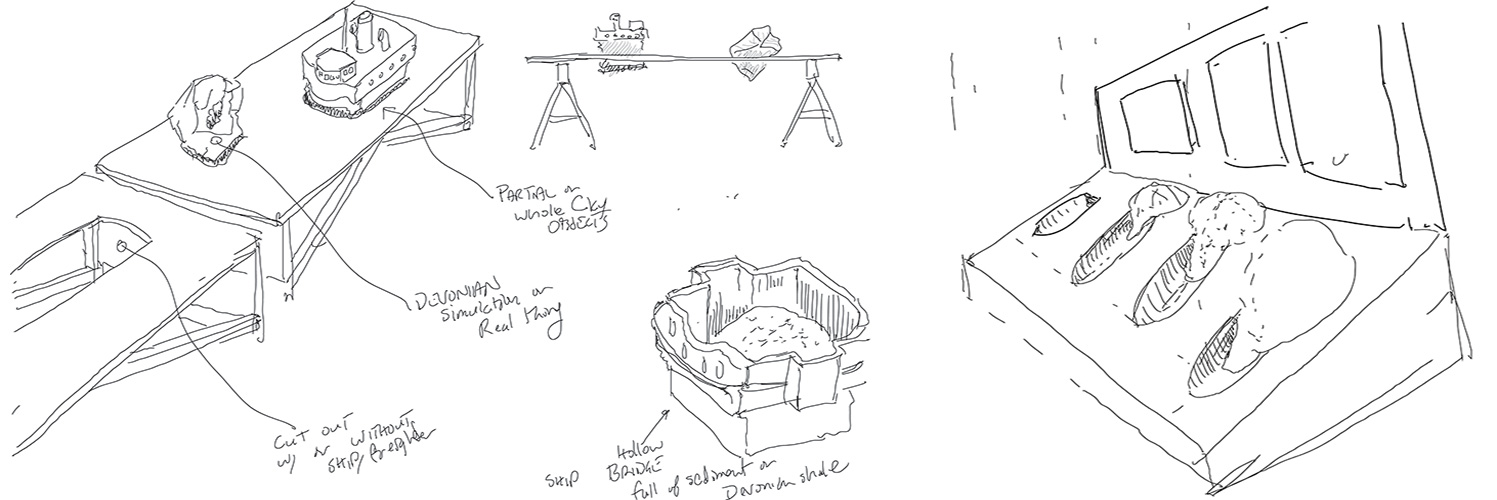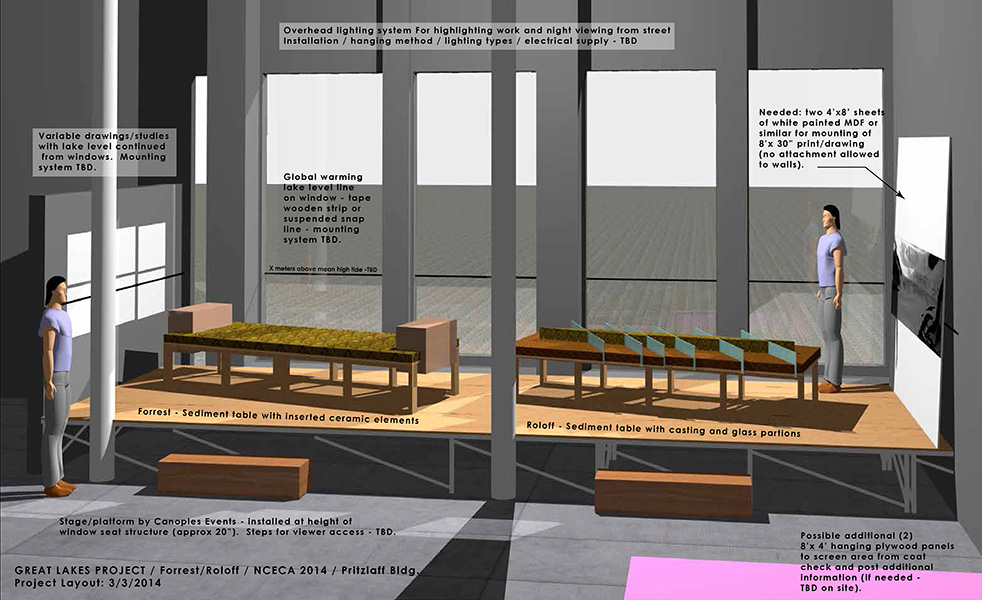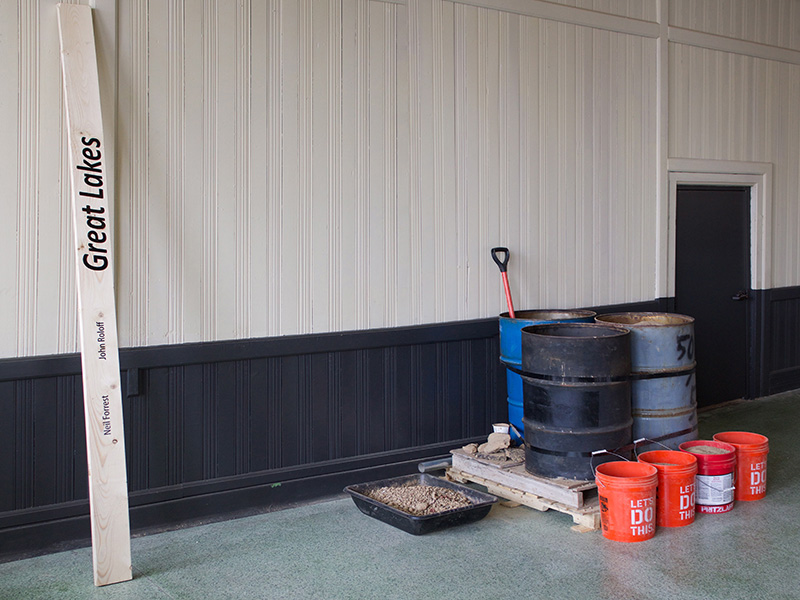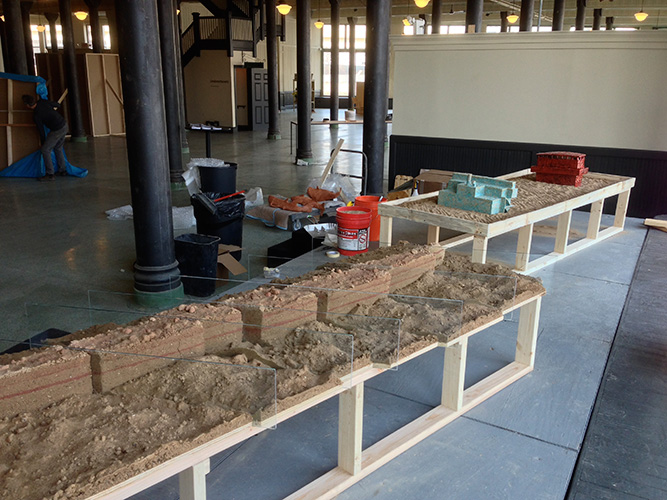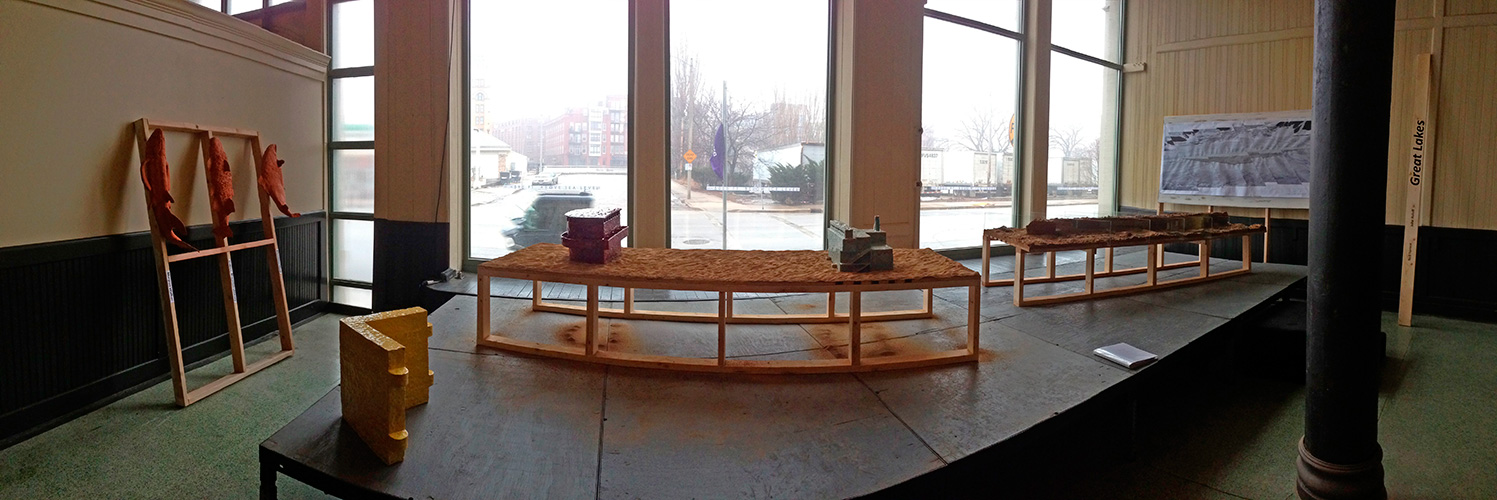Top: Great Lakes Project - Study: Expanded Store Front/Window Space Option / anearly study for Great Lakes installation originally seeking a discrete store front venue.
Bottom: Great Lakes title board and S. E. Wisconsin glacial till sediment repository and processing component for Great Lakes, material used for the Forrest/Roloff tableau components. |
Top: Great Lakes Project - Potential Native Clay/Sediment Sources / exemplary site research for Great Lakes.
Bottom: Installation in progress / foreground - John Roloff, tableau element of S. E. Wisconsin glacial till, glass, wood. 41 in. x 108 in. / background right - Neil Forrest, tableau element of S. E. Wisconsin glacial till, wood and fired/glazed clay. |
Top: Exemplary concept sketches for Great Lakes.
Bottom: Panorama of the stage area of Great Lakes // Left - fish imges on wooden frame by Elizabeth Houg, Gillian Maradyn-Jowsey and Morgan Walker, students at NSCAD and Neil Forrest installation, the ship bridges are American stoneware with earthenware glazes, the fish are Nova Scotian terra cotta and the sediment that surfaces the table top is glacial till from S. E. Wisconsin, wood // Right - John Roloff's installation / wall - Study: Land/Sea Analog / Terrane Displacement, pencil, acrylic and inkjet on vellum, 40 in. x 95 in. / center - tableau element of Study: Land/Sea Analog / Terrane Displacement / S. E. Wisconsin glacial till, glass, wood. 41 in. x 108 in. / windows: text strips denoting "5000 ft below ice level, inkjet on vellum.
A large commercial stage component created an elevated platform for the Forrest/Roloff tableau works at the level of the Pritzlaff windows. |
Top: Great Lakes Project / Exemplary rendered computer study for Great Lakes installation.
Bottom: John Roloff / wall - Study: Land/Sea Analog / Terrane Displacement, pencil, acrylic and inkjet on vellum on wood/sheet rock frame, 40 in. x 95 in. / center - S. E. Wisconsin glacial till, glass, wood. 41 in. x 108 in. / windows: text strips denoting "5000 ft below ice level," inkjet on vellum.
Detailed information about: Study: Land/Sea Analog / Terrane Displacement. |
Great Lakes
Neil Forrest / John Roloff
NCECA 2014 / Milwaukee, WI / Pritzlaff Building
For Great lakes, Neil Forrest has cropped pieces of the distinctive lake freighter typologies to suggest the present currency of the Great Lakes as a transportation and economic engine. In the metaphorical background, is Michel Foucault allegory of ships as the ‘endless journey’ (Foucault’s idea of the transiting ship). This heterotopia rides in contrast with the modeled Devonian period fish and the new invaders. The prehistoric and invasive fish were modeled by upcoming ceramic artists Elizabeth Houg, Gillian Maradyn-Jowsey and Morgan Walker, all introductory ceramic students at NSCAD University in Halifax, Nova Scotia.
The ship bridges are American stoneware with earthenware glazes, the fishes are Nova Scotian terra cotta and the sediment that surfaces the table top is glacial till from S. E. Wisconsin. |
For Great Lakes, Roloff’s graphic work: Study: Land/Sea Analog / Terrane Displacement, and it’s companion tableau element of wood, glacial sediment and glass, investigates the Pleistocene, glacial, genesis of the the Great Lakes and related terrains/terranes globally. In the graphic component, the physically offset image of the contemporary archetypal, Columbian Ice Fields of the Canadian Rockies is echoed in the adjacent tableau sculpture, of a ship and environment composed of S. E. Wisconsin sediment undergoing displacement by glass ‘fault’ planes. This assemblage suggests analogs to generative processes of local glacial transport and displacement as well as larger systems of land and sea evolution. The Wisconsin terrain may be visualized as strati-chronographically generated and situated between a mile (or more) thick sea of ice, ancient hydrologic and marine environments and the contemporary oceans of some -600 ft. below datum.
|
Great Lakes / Original Project Concept:
This exhibition examines the history of what is known as the Great Lakes, born during the recent ice ages and locus of a wide range geo-materiality. As a hydrologic system, the Great Lakes, in human time, has provided a tableau for exploration, transport and climate generation, while the area bordering the Great Lakes is extraordinarily enriched zone of substance and production. The relationship of these domains have created complex and varied narratives unveiled by the artist's extensive site research into the cultural, industrial, geologic and histories of Milwaukee and the SE Wisconsin terrain. The exhibition “Great Lakes” is essentially two solo works by two artists on the same theme with different interpretations of the research and site, using similar materials on a common platform. These two clay and media assemblages each explore the unique transport/geology/mined materials (& manufactured) engendered by the Great Lakes system and its history. The exhibition considers salient aspects of Great Lakes history and Milwaukee’s context within it, using examples and analogs of glacial and lacustrine systems, trade, architectural design, transportation and prosperity that relate to the origin, conveyance and use of raw and processed materials in this region. Great Lake freighters and other historical vessels to glacial, geo-transport and ore analogs are inspirations of material transformation localizing Milwaukee within the Great Lakes, and the Great Lakes within a continental narrative of origin, transport and production.
In addition to the history of Forrest and Roloff's use of the ship image, Michel Foucault allegory of ships futher frames the exhibition's concept. The ‘endless journey’ (Foucault’s idea of the transiting ship) provides our heterotopia – an approximation of a utopia, or a parallel space, expressed through both cultural and natural systems of substance, metaphor and evolution. Additional ship and material influences include: the famous cream brick of Milwaukee, the Milwaukee Deep Tunnel System, the hydrologic system of both the Great Lakes and the Milwaukee area, the Pleistocene central NA glacial episodes and the deeper regional geologic structures. Exposures of the Maquoketa shale, Menomonee Valley clay deposits, unconsolidated river and lake sediments and transported metalliferous ores are considered as potential raw materials for site-based fabrication.
|
Other Projects by Forrest/Roloff
Perils in the Sublime / NCECA 2009 / Phoenix, AZ
Diderot/Forrest/Roloff / NCECA 20174 / Portland, OR
Return to Recent/Selected Projects Page
Return: Shear Zones: Displacements/Permutations over 40+ Years of Ceramic Practice
|
